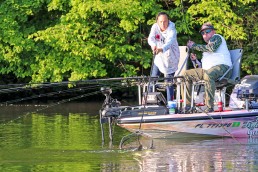Catching Crappies 365 Days a Year
SHARE THIS POST
When it comes to crappie fishing, Tim Huffman will tell you that experience and solid tactics increase the odds of being successful at any time of the year.
Technique
The fishing team of Eric and LeAnn Howard won the Male/Female Angler of the Year title and finished sixth in the 2022 Crappie USA Winter Series Championship. They are also owners of HH Rods & Reels and Foxy Fishing Gear. The team uses a wide variety of techniques.
“We fish tournaments in a lot of different lakes and rivers every year,” says Eric Howard. “Techniques are important because a fisherman may need to spider rig, longline or single pole. And it doesn’t matter the time of year. Temperatures are really important to where the fish will be located and which technique is best.”
Howard says the type of water, cover and water temperature all play a part in determining how to fish. For example, crappies may be in the pads, so dipping with a long pole will be the best choice. Fish suspended in open water can be long-lined or baits can be pushed. Every situation is different, so being versatile is important.
“It helps to have a great partner who doesn’t mind changing tactics and has characteristics and skills you that may not have.”
The team excels at several techniques including spider rigging. Howard says, “We use 16-foot poles to get baits away from the boat. The HH Williams series Soft Touch poles are made for spider rigging and are especially good for black crappies because the poles are limber. Tips are fluorescent-colored so it’s easier to see bites.”
Baits
Howard says matching the bait to what the fish are eating is critical, it doesn’t matter which state you are fishing.
Brad Chappell, a fishing guide and host of the Crappie Connection podcast, uses longlining as his primary technique. “It’s a good search method because so much water can be covered. My go-to baits are Bobby Garland 2.5-inch Stroll’R jigs because they have a medium-large profile and good action. I may be using two 1/8-ounce jigs in deep water or two 1/32-ounce jigs for very shallow depths. I usually run from 1.0 to 1.2 mph.”
Todd Huckabee, a popular guide/pro from Oklahoma, prefers a larger bait. “I use a Beaver Bottom jig with a Redneck Rubber Raptor head. For LiveScoping, The Beaver Bottom is a medium-large profile body with soft ribs that cause fish to hang on to it longer. The Raptor jig has a big, strong hook needed when LiveScoping with a long, stiff rod. I use a Huckabee rod and braided line, so there is a lot of leverage generated that will bend the hook on a standard jig. The Raptor was made to eliminate that problem. That setup works for me.”
Find fish quickly
“It’s all about finding fish,” says Chappell. You’ve got to find a pattern and effectively catch them.”
Are you enjoying this post?
You can be among the first to get the latest info on where to go, what to use and how to use it!
Chappell says a fisherman with less experience may have trouble picking up on the details of what is going on while fishing. The solution is to keep an open mind and eliminate pre-conceived ideas about where fish should be caught. A fisherman should be quick to change depths and areas until active fish are found.
“On an unfamiliar lake, start by looking at maps. In cooler water, it will be deeper main-river channels. Places picked are determined by the time of year. I’ll start fishing and adjust as necessary by working my way to shallower water.
“Finding fish is a matter of looking and figuring out a pattern. Don’t get stuck. Keep experimenting.”
North to south
Seasons are very different in Wisconsin compared to Texas. The northern states have ice fishing and a shorter open-water time frame. 365-day-a-year crappie catching can be challenging, but the variety of opportunities are great.
Southern fishing is in soft water all year. There are many big fish in the South because of longer growing seasons. Numbers of fish are often good. Unless wind or flood prevents getting a boat out on the water, fish can be caught, or at least pursued, every day of the year.
The mid-states are in between, with waters sometimes freezing over. Recent warm winters have led to more days available to get boats out on the water.
Final thoughts
A fisherman who can fish two or three techniques has better opportunities to catch fish, no matter where they hide or hang out. The season and water temperatures, along with current weather and water conditions, determine where fish will be located.
Pick the right baits. Tiny jigs and minnows may be critical to getting bites. Big fish in other states may prefer a huge bait. If you’re unsure about the right bait size, check fishing reports and ask questions. Or start with medium baits and move to smaller ones if there are no bites. Make changes when you’re not catching fish.
If you enjoy panfishing, you’ll find plenty of suggestions for locations and techniqies in every issue of MidWest Outdoors, available by subscribing on our website.
MWO
SHARE THIS POST
You may also like...
Nothing found.
Did you enjoy this post?
You can be among the first to get the latest info on where to go, what to use and how to use it!
Tim Huffman
Tim Huffman specializes in crappie fishing, is editor for two crappie magazines, as well as writing for several others. In 2018, he published his sixth book, Limiting Out for Crappie, available at Amazon. His first article appeared in MidWest Outdoors in 1988.
